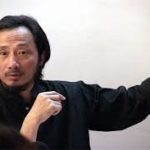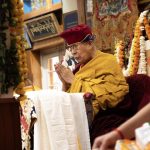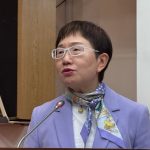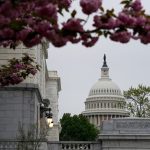Hong Kong Protests Cloud China’s National Day
October 01, 2014 7:23 AM
BEIJING—As China marked its National Day Wednesday, a defiant gathering of thousands of people in Hong Kong demanding deeper electoral reforms for the port city cast a shadow over Beijing’s celebration.
At a flag-raising ceremony to mark the holiday in Hong Kong, protesters booed and made a “thumbs down” sign as helicopters flew overhead. There were also shouts for Hong Kong’s leader Leung Chun-ying, who was in attendance, to step down.
Hong Kong Q&A: Susan Yackee and Ivan Broadhead

Student protesters shout slogans outside the Golden Bauhinia Square, venue of the official flag-raising ceremony for celebrations of China’s National Day, in Hong Kong Oct. 1, 2014.
Hands off for now
For now, China is largely taking a hands-off approach to the protests that would be unthinkable in the mainland. But as the demonstrations drag on they are likely to become an even bigger challenge for Beijing, leaving authorities with few options to respond.
Some have raised concerns that Hong Kong officials might turn to Beijing for support in curbing the protests, possibly using force. While fears of a Tiananmen-like crackdown have circulated, China’s Communist Party-backed newspaper the Global Times tried to quell concerns over the possible heavy-handed response.
In an editorial this week that focused on how – as it put it – radical activists were threatening Hong Kong’s image and economy, the newspaper argued that China is no longer the same country it was 25 years ago when the Tiananmen incident occurred.
The editorial said that China has much more experience now in handling social disorder and that it has learned lessons from others.
Bill Bishop, a China analyst and publisher of the influential Sinocism China newsletter says it is still too early to tell just how Beijing will respond.
Bishop Tweeted on Wednesday that while he felt it was unlikely that there would be a repeat of the events of 1989, dismissing the possibility would be a mistake.
One country, two systems
When Britain handed over Hong Kong from colonial rule in 1997 a form of government known as “one country, two systems” was set up to ensure that basic freedoms were upheld.
Public rallies are common in the port city, but the protests Hong Kong is now experiencing are the largest and most confrontational since it was returned to China and set up as a special administrative region.
China chafes at any attempts to challenge its authority, but one reason it may be taking a hands off approach for now, some analysts say, is because the basic demands of the protesters are for universal suffrage and not an attempt to challenge the form of rule that is in place in Hong Kong.
Su Hao, a professor from Beijing Foreign Affairs College says it is because of the “one country, two systems” model that China is showing some restraint and not intervening.
“It would be inappropriate for the central government to interfere directly, because after all, it is Hong Kong’s internal affairs,” Su said.














